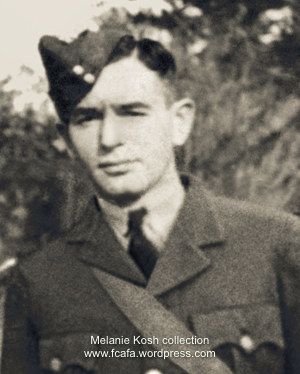
Jaromír Drmelka
311 Sqn pilot
..* 14.03.1917, Vyklice, Czechoslovakia.
..† 18.08.1942, Bay of Biscay.
Před válkou: Pre WW2:

Chtěli bychom věnovat vzpomínku na našeho letce RAF 311 perutě Jaromíra Drmelku, který je vzpomenut na pomníku padlých u školy v Halenkovicích na Moravě. Po Mnichovské dohodě z roku 1938 kdy Němci zabrali Sudety se Drmelkovi museli nuceně vystěhovat z Vyklic které byly bohužel součástí německých Sudet. Tenhle smutný uděl postihl mnoho dalších českých rodin. V důsledku těchto početných případů nastal chaos a problémy s umístěním vystěhovaleckých rodin, proto vzniklo vládní nařízení, dle kterého se každé vystěhovalecké rodině dostalo domovského práva v obci rodišti hlavy rodiny. A jelikož se Jaromírův otec František Drmelka narodil v Halenkovicích tak právě zde se rodině Drmelkové dostalo domovského práva. Tohle je také důvod, proč po válce v červenci 1945 bylo zasláno oznámení o Jaromírově úmrtí do Halenkovic a taktéž je i jeho jméno uvedeno na zdejším pomníku padlých.
We would like to remember our 311 Squadron RAF airman Jaromír Drmelka, who is remembered on the war memorial near the school at Halenkovice, Moravia. The reason he is remembered is because, along with many other Czech families, the Drmelka family was expelled by the Germans following the 1938 Munich Agreement and forced to move away from Vyklice, which is in the Sudetenland region of Czechoslovakia. The consequence of forcing these families to relocate resulted in numerous instances of chaos and administrative problems for the authorities. This caused a Government legislation to be passsed whereby every expelled family had to be administered by the Municipal Office at the birthplace of the head of the family. As Jaromír´s father, František Drmelka, was born in Halenkovice, it is why, in July 1945, Halenkovice was sent the notification of Jaromír’s death during WW2 and thus why he was remembered on the Halenkovice memorial.
Jaromírův otec František se narodil v Halenkovicích, ale velmi mladý odchází a je zaměstnán v Mariánských Horách u Moravské Ostravy jako strojník. Posléze se usadil i s rodinou ve Vyklicích a právě tam se mu později narodil syn Jaromír Drmelka.
Jaromír´s father František Drmelka was born in Halenkovice. Later František left Halenkovice and was employed as a machinist in Mariánské Hory near Moravian Ostrava and then settled with his family in Vyklice. It is here that Jaromír was born.
Okupace 1939: Occupation 1939::
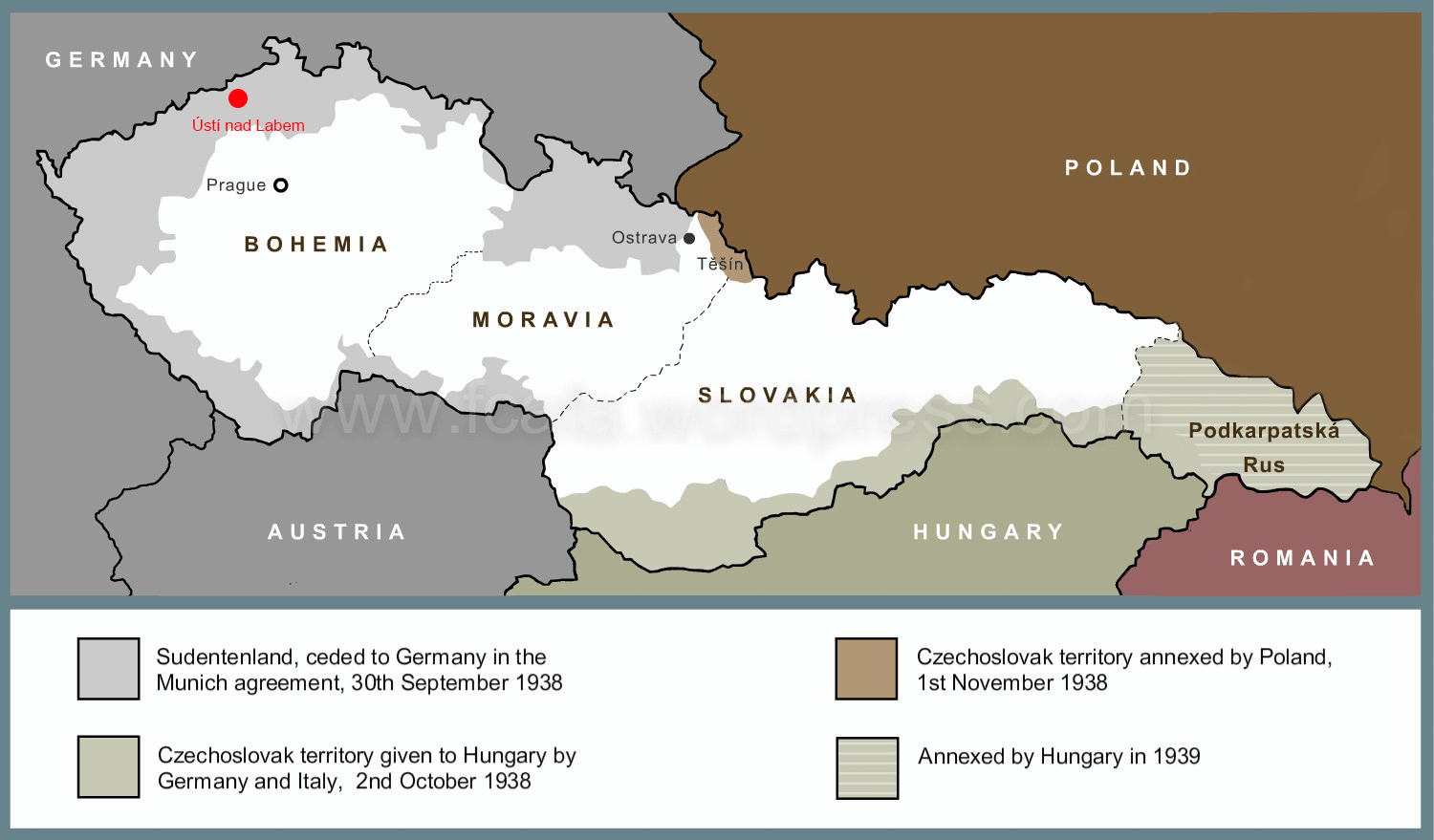
Pohraniční Vyklice /Ústí nad Labem/, kde se Jaromír Drmelka narodil, byly obsazeny Němci. Byly to tak zvané německé Sudety. Z rodinných zdrojů víme, že Němci vzali rodině Drmelkové dům a veškerý majetek a udělali z něj ´´Hitlerheim´´německé mládeže. Celé rodině vzali i nemocenskou a tatínkovi penzi. Maminka byla těžce nemocná a když Jaromír odcházel z domu měl obavy jestli se vůbec s ní někdy znovu setká.
Vyklice, near Ústí nad Labem, was in the border region – the Sudetenland – of Czechoslovakia and was occupied by the Germans following the Munich Agreement of September 1938. From family sources, we know that the Germans confiscated the Drmelka family house and all their property and declared that the house was now a ”Hitlerheim” – a house for German youth. The Germans took all the families sickness insurance and František Drmelka pension money. Jaromír’s mother was seriously ill and when he left home he was worried that he might never see her again.
Neměli peníze na léky a ani na jídlo, po nuceném vystěhování z vlastního domu se rodina Drmelková musela uchýlit na Moravu k příbuzným. Avšak Jaromír a jeho bratr Olda se skrývali nadále ve Vyklicích. Na vlastní kůži poznali teror a řádění henleinovských ordnerů v českém pohraničí a nemohli se s tím smířit. Chtěli bojovat za vlast proti nacistickému Německu a tak čekali na příhodnou chvíli uprchnout za hranice. Jaromír se měl hlásit k 1. srpnu 1939 na Gestapu v Magdeburku, ale v té době byl už v Polsku. Z domova odešel 20. července a měl obavy, aby tatínek kvůli tomu, že utekl z Německa neskončil v koncentračním táboře. Uvědomoval si, že tím uvrhl celou rodinu do velkého nebezpečí, ale jak sám řekl ´´Je to má povinnost a také pro všechny kdo se Čechem cítí a kdo miluje svou vlast´´.
The family had no money for medicines and even for food so after they were forced to leave their own home, the Drmelka family had to rely upon relatives in Moravia for support. However Jaromír and his brother Olda stayed and went into hiding in Vyklice. They knew well about the orders of Konrad Henlein, the leading Sudeten German politician in Czechoslovakia, to spread terror in the Czech border regions and they could not tolerate this. They wanted to fight for the liberation of Czechoslovakia against Nazi Germany so they were waiting for the right moment to escape across the border. On August 1, 1939 Jaromír was required to report to the Gestapo in Magdeburg, but by that time he had already escaped to Poland. He left home on July 20 1939 and was afraid, that because he was escaping from Czechoslovakia, now a Reich Protectorate, that his father could be sent to a concentration camp. He realised that his escaping would put whole family into great danger but as he said “it is my duty and also for all those who feel Czech and who love their country.”

Jaromír Drmelka se narodil 14. 3. 1917 ve Vyklicích /okres Ústí nad Labem/ jako druhý syn Františka a Otilie Drmelkové. Měl ještě dvě sestry Ludmilu a Jiřinu. Ve vyklickém domě který postavil jeho tatínek měli hospodu a masnu kterou provozovala maminka Otilie a tatínek František dělal horníkům mistra v dole u Vyklic. Jako malý chlapec Jaromír vychodil obecnou a měšťanskou školu v Chabařovicích a od deseti let aktivně cvičil v Sokole. Absolvoval 3 roky odborné pokračovací a 2 roky strojní průmyslové školy v Ústí n. Labem. Jeho rysy byly vyvěšeny na chodbách průmyslové školy a v té době měl také několik zlepšovacích návrhů, o kterých se jeho profesoři pochvalně vyjadřovali. Tato škola byla německá a česká průmyslová škola tam byla trpěna pouze v nájmu. Byla to velmi těžká politická situace pro Čechy, kteří žili v severočeském pohraničním území. I když musel předčasně tuto školu opustit kvůli finančním problémům tak jeho úspěchy ještě po letech vzbuzují obdiv. Jeho sestra Ludmila vždy říkala, že Jaromír byl opravdu velmi schopný a talentovaný student a zůstaly jen smutné vzpomínky na zmařený mladý život.
Jaromír Drmelka was born on 14. 3. 1917 in Vyklice, near Ústí nad Labem, in north east Czechoslovakia. He was the second son of Frantisek and Otilie Drmelka. He had also two sisters Ludmila and Jirina. The family home in Vyklice had been built by his father. The village had a public house and a butchers shop which was run by his mother Otilie. His father Frantisek was a Master-miner at the mines at Vyklice. As a little boy Jaromír attended elementary and secondary school in Chabařovice and when he was ten years old he became a member of Sokol, the Czechoslovak youth sport organisation. On completion of his secondary schooling he continued with his education for a further two years at the industrial technical school in Ústí nad Labem, where he studied engineering. The school was in the Sudeten region of Czechoslovakia and despite being a German-Czech school managed to remain apolitical in the difficult situation that was now developing in the Sudeten regions. From his sister Ludmila we know that whilst he was at the technical school, he loved designing and his drawing were displayed in the corridors of the school. He was noted for several innovative design suggestions which were received well by his lecturers. Unfortunately, due to the families poor financial situation he was forced to leave. His sister Ludmila always said that he was a promising and really talented student and “remain only sad memories of a young wasted life”.
Československé letectvo:
Czechoslovak Air Force:
Dne 27.4.1937 byl přijat do praktického pilotního výcviku v akci letecké branné výchovy. Jaromír byl vysoký a kvůli tomu měl problém s přijetím do leteckého výcviku, ale nakonec se mu to podařilo a jeho sen létat se mu vyplnil. Zkoušku na pilota sportovních a turistických letadel vykonal dne 22. 8. 1937. V říjnu 1937 nastupuje na vojenskou službu a 15. 11. 1937 je zařazen do poddůstojnické školy v Chebu. Do vojenského pilotního výcviku je zařazen dne 26.11.1937. O rok později je povýšen na svobodníka. V ČS Armádě byl 2 roky vojenským pilotem. Po rozpuštění ČS armády byl poslán do Hamburku na práci, odtud po 2 měsících utekl zpět do Protektorátu a potom přes Slovensko do Polska.
On April 27 1937, Jaromír applied for practical pilot training, but because he was quite tall, he had problems to be accepted for flight training, but finally he was accepted and his dream of flying was realised. He qualified as a sports pilot on August 22, 1937. In October 1937 he started his military service and on November 15, 1937 he was assigned to NCO Military School in Cheb. He commenced his military pilot training on November 26, 1937. A year later he was promoted to the rank of svobodník (Private First Class). He served as a pilot in the Czechoslovak Air Force for two years. After the German occupation in March 1939, the Czechoslovak Air Force was disbanded and he was sent to Hamburg to work but after two months he escaped back to the Protectorate, and then escaped to Poland via Slovakia.
Do Polska: To Poland: :
V červenci 1939 přechází hranice do Polska, kde byl prezentován u východní skupiny čs. armády v polském Krakově. Posléze přemístěn do tábora v Malých Bronovicích a zařazen do čs. legionu. Potom celá čs. skupina byla odeslána do Leszné na ruské hranice.
His escape to Poland was in July 1939, and after crossing the border, he reported to the Eastern Czechoslovak Army Group in Krakow. Later he was transferred to the Czechoslovak transit camp at Malé Bronovice, near Krakow, here he joined the Czechoslovak Legion. Following the German invasion of Poland on September 1, 1939, the entire Czechoslovak group was redeployed to Leszno, near the Russian border.
Při ústupu před postupující německou armádou byli několikrát bombardováni a asi po 3-4 denním cestování na malé zastávce před Lublinem 6. 9. 1939 se J. Drmelka s dalšími několika kamarády odpojili od skupiny, protože ztratili transport a vstoupili do řad polského letectva. Přihlásili se na velitelství v Lublině. Z velitelství je poslali k 6 Pułk Lotniczy. Piloti byli přiděleni k 64 a 65 Eskarda Bombowa. Eskadry byly vyzbrojeny letadly PZL P. 23B Karaś. Němci byli velmi překvapeni, jak statečně polští letci podnikali nálety na postupující kolony Wehrmachtu, bohužel německá přesila byla příliš velká a polská letadla utrpěla devadesátiprocentní ztráty.
During their retreat front of the advancing German army, the group was bombed several times, and after about 3-4 day’s traveling arrived at Lublin. It was here, on September 6, 1939, that Jaromír with a few other friends became separated from the rest of group and they lost their transport. They decided to join the Polish Air Force, whose headquarters were in Lublin, where they enlisted. They were deployed to the 6 Pułk Lotniczy of the Polish Air Force and were assigned to the 64 and 65 Eskarda Bombowa units, who were equipped with PZL P. 23B Karaś aircraft. The advancing Germans were very surprised how the brave Polish airmen made raids on the Wehrmacht army, but German superiority was too much and the Polish Air Force suffered with 90% aircraft losses.
Pobyt u polských jednotek trval pro Jaromíra a jeho kamarády jen pár dní. Po zničení neletuschopných letounů odletěli v noci ze 17. na 18. 9. 1939 na zbylých letadlech spolu se zbylým personálem eskader do Rumunska. Zde je zajat a internován v táboře Babadaj. Posléze utíká z tábora Babadaj přes Bukurešt‘ do rumunského přístavu Constance. Z tama pak dále odplouvá 14. 10. 1939 lodí Besarabia do Bejrútu a pak pokračuje svou cestu na lodi Maréchal Joffre. 13. 11. 1939 připlouvá do Marseille, Francie, a odtud odjíždí do Agde.
However their stay with the Polish Air Force lasted only a few days. On the night of 17/18 September 1939, after they destroyed their non-flight capable aircraft, the Eskarda flew their remaining aircraft to Romania. Here they were interned and held at the Babadaj internment camp. Jaromír managed to escape from the camp, and travelled via Bucharest to the Romania port of Constanța. From here, on 14 October, he sailed on the ship ‘Bessarabia’ to Beirut and there he boarded the ‘Maréchal Joffre’ and continued his journey to France.
Do Francie:
To France:
Je prezentován u čs. vojska v Agde a zařazen do letecké skupiny a 15. 12. 1939 je povýšen do čs. hodnosti desátníka. Poté, 6. 6. 1940 je přemístěn k doplňovacímu středisku čs. letectva v Bordeaux.
He arrived at Marseille on 13 November and was transferred to the Czechoslovak military transit camp at nearby Agde. Here he was assigned to the Air Force group and on 15 December 1939 was promoted to the Czechoslovak rank of desátník (Corporal) and assigned to Armée de l’air, the French Air Force. On 6 June 1940, during the Battle for France, he was redeployed to their airbase at Bordeaux.

At Training School, Babbacombe Hotel.
Po pádu Francie dne 19. 6. 1940 byl s dalšími československými piloty evakuován na lodi Karanan do Velké Británie. 21. 6. 1940 připlouvá do anglického přístavu Falmouth.
After the fall of France he was amongst the group of Czechoslovak airmen who were evacuated on the ‘Karanan’. The Dutch motor coaster sailed from France on 19 June and arrived at Falmouth, England on 21 June.
RAF:

2. SFTS, Brize Norton.
Nejprve byli českoslovenští letci převezeni do RAF Innsworth a 9. 7. 1940 je zařazen do Czechoslovak Depot RAF Cosford a 24. 7. 1940 je přijat jako dobrovolná záloha do RAF /Royal Air Force/. Obdržel kmenové číslo 787359 a je mu přidělena hodnost AC2. Základní pilotní výcvik absolvuje u No. 1 RW /Receiving Wing/ Babbacombe Down /Devon/ a poté je přemístěn do No. 2 SFTS /Service Flying Training School/ Brize Norton k pokračovacímu výcviku. Dne 4. 8.1941 byl povýšen do britské hodnosti sergeant a pak jako pilot 1.1.1942 je přeřazen k 311. čs. bombardovací peruti v East Wretham, Norfolk/.
Initially the Czechoslovak airmen were taken to RAF Innsworth and, on 9 July, they were transferred to the Czechoslovak Depot at RAF Cosford. Jaromír was accepted into the RAF Volunteer Reserve on 24 July, at the rank of AC2, and the service number of 787359. He was posted to No. 1 RW (Receiving Wing) at Babbacombe Down, Devon to attend his elementary pilot training course. On completion of the course he was then sent for further pilot training to No. 2 SFTS (Service Flying Training School) at Brize Norton. On 4 August 1941 he was promoted to the RAF rank of Sergeant and on 1 January 1942 was transferred to 311 (Czechoslovak) Bomber Sqn based at East Wretham, Norfolk.
U 311. perutě: 311 Sqn:
Po 310. stíhací to byla druhá čs. peruť v rámci Britského Královského letectva. Ve svém znaku měla dvojici zkřížených husitských zbraní s citátem „Na množství nehleďte“. Hlavní úkol perutě byl jeden z nejnáročnějších. Jednalo se o noční bombardování nad územím nepřítele, proto i výcvik byl odlišný a mnohem náročnější než u ostatních. Každý musel znát svou odbornost a bezpečně ovládat anglické povely a vojenskou terminologii. Museli si zvyknout na rytmus denních a nočních dálkových letů nad pevninou a nad mořem a na specifické anglické podmínky.
The squadron was, after 310 Czechoslovak fighter, the second Czechoslovak squadron, squadron to be formed within the RAF. Their squadron badge was a pair of crossed Hussite weapons with the motto “Never regard their numbers”. The role of the squadron was one of the most demanding; it was the night bombing of targets in occupied northern Europe. Their training was therefore different and much more difficult than their 310 Sqn counterparts. Everyone had to be an expert in their own aircrew roles and to be fully conversant with English commands and military terminology. They had to get used to the rhythm of day and night flights over land and over the sea and the specific English environment.
Od února do června 1942 je Jaromír u československé operačně-výcvikové letky – No.8 u 1429 COTU /Czechoslovak Operational Training Unit/ v Honingtonu jako druhý pilot dvoumotorového Vickers Wellingtonu zařazen do operačního turnusu. Dvoumotorové bombardovací stroje typu Wellington byly v té době nejmodernější a zároveň nejkomplikovanější bombardovací letouny s nimiž se naši letci do té doby setkali. Osádku šestimístného Wellingtonu tvořili první a druhý pilot, navigátor, radiotelegrafista a přední a zadní střelec.
Initially, from 1 February to 14 June 1942, Jaromír was assigned to No. 8 Course at 1429 COTU (Czechoslovak Operational Training Unit), based at Honnington, for operational training as second-pilot on Vickers Wellington, twin-engined bombers. At that time these was the most advanced and, at the same time, complicated bomber aircraft that Czechoslovak airmen had flown. A Wellington aircraft was manned by a crew of six – a pilot, co-pilot, navigator, wireless operator and two air-gunners.
Ke konci výcviku se šest posádek z tohoto kurzu zúčastnilo druhého tisíci letadlového bombardovacího nočního náletu na Essen. V noci z 1. na 2. června 1942 vzlétl Jaromír s ostatní posádkou na Wellingtonu jako třetí a i přes nízkou oblačnost překrývající jejich cíl nakonec úspěšně splnili misi a shodili bomby na přesně určené místo.
Towards the end of this training period six of the crews from that Course participated in the 2nd 1000 bomber raid. Their target was Essen on the night of 1st/2nd June 1942. Jaromír Wellington was the 3rd to take-off and despite low cloud obscuring their target, they successfully reached their target and dropped their bombs.

Dne 17. června 1942 Jaromír úspěšně dokončil výcvikový kurz a je přemístěn zpět k 311. čs. bombardovací peruti. Bohužel kdokoliv se přihlásil k bombardovacímu letectvu a byl zařazen k operační letce si musel být plně vědom toho, že má před sebou asi tak půl roku života. Nic míň a nic víc, po této době musel být už jen dítkem štěstěny a takových nebylo mnoho.
On 17 June, having successfully completed his course, Jaromír re-joined 311 Sqn. Whoever joined a operational RAF bomber squadron was quite aware that their life-expectancy could possibly be no more than six months. Nothing less and nothing more, those who survived that period must have been a child of fortune and there were not many of those!
Chtěli jen létat a počítali s tím, že mohou padnout. Nebo být zajati, což bylo pro občany okupované vlasti ještě horší, pokud nacisté zjistili jejich totožnost, hleděli na ně jako na uprchlé zrádce. U Bomber Command byla životnost osádky velmi nízká. Velkou hrozbu představovali nepřátelské stíhačky a pro střelce bombardérů to byl velmi těžký úkol zneškodnit je. Většinou neměli téměř žádnou šanci na přežití jakmile byli obklopeni tak obávanými německými stíhačkami Messerschmitt. Zbývá jen dodat, že šance osádky zasaženého letounu dostat se z letadla živí byla zhruba 1:5. Mnohými byly bombardovací nálety označovány za sebevražedné mise. Každý člen posádky bombardovacích letounů měl méně jak padesáti procentní šanci na přežití a během 2. světové války jich bylo zabito celkem 55,573.
They just wanted to fly and accepted the fact that they may fall. Or be captured, which for the citizens of their occupied homeland would be even worse when the Nazis discovered their identity, regarding them as traitors to the Reich. For Bomber Command aircrew, life-expectancy was very low. The big threat was enemy fighters and for the bomber gunners was a very tough job to shoot them down. Usually they had no chance of survival when were surrounded by so fearsome Luftwaffe fighter-aircraft. It remains only to say that the crew chances to get out from a damaged aircraft alive was about 1 in 5. For many, bombing raids were described as a suicide missions. A aircrew member of Bomber Command had a less than 50% chance of survival; a total of 55,573 RAF Bomber Command aircrew were killed during WW2.
Velká Británie byla životně závislá na dodávkách zásob ze Severní Ameriky. Toto zásobování zajišťovaly konvoje nákladních lodí. Konvoje však byly terčem útoků německých ponorek /U-boat/. A jelikož v té době 311. bombardovací peruť měla vysoké ztráty a hrozil jí totalní zánik tak bylo rozhodnuto o jejím přesunu dne 28. dubna 1942 ke službě u pobřežního velitelství k zapojení se do Bitvy o Atlantik.
On 28th of April 1942, because of the German U-boat threat to Britain’s vital supply convoys from the United States combined with the high personnel losses they suffered in Bomber Command, 311 Sqn were transferred to Coastal Command for their role in the Battle of the Atlantic.
Pobřežní velitelství : Coastal Command:
Zpočátku 22. června 1942 byla 311. bombardovací peruť přeřazena do RAF Talbenny v Pembrokeshire i s Jaromírem, který byl nyní nasazen jako operační pilot. Žádalo si to neuvěřitelnou odvahu sednout si dovnitř bombardéru ve dne i v noci a absolvovat několika hodinové mise v mrazivém vzduchu. Pokaždé když vzlétli, věděli, že letí na skoro jistou smrt. Většinou 8 až 10 hodinové mise na hraně smrti v úzkém prostoru letadla i v zimě, kde teplota byla pod nulou a v neustálé obavě o život, byly pro mladé muže velký nápor na nervy. Ti kluci tam přišli sami, dobrovolně a bez říkání opustili svoje rodiny v rodné zemi. Byli to naprostí idealisti a vlastenci, ale jak strašnou cenu za to někteří museli zaplatit tím, že jsou tam pohřbeni v Biskajském zálivu nebo v Severním moři. Šestičlenná posádka musela být dokonale sehraná, bojovali a umírali často společně. Bylo to peklo, nic jiného od toho nečekali. A jak Jaromír napsal v jednom svém dopisu ’’ Zůstalo nám hodně a hodně smutných vzpomínek a tvrdých, ten kdo je neprožil těžko by jim uvěřil’
Initially, from 22 June 1942, 311 (Czechoslovak) Sqn were deployed to RAF Talbenny, in Pembrokeshire, with Jaromír now an operational pilot. It required incredible courage to be inside their Wellington aircraft day and night and complete long patrols in the frosty air. Every time when they took-off knew, the certainty of their return was unknown. The long patrols, usually between 8 to 10 hours, always had the danger of death in the narrow confines of the aircraft, where the cold temperature was below zero, and the constant fear for theirs lives would put a great strain on the nerves of these young men. These men had escaped voluntarily from their homeland to be there, often leaving their families in their native Czechoslovakia. They were absolute idealists and patriots, but for some they paid the ultimate sacrifice – a watery grave in the Bay of Biscay or the North Sea. The six-member crew had to be perfectly harmonised as often they fought and died together. It was hell, but they fully expected that. In one of Jaromír’s letters he wrote “It remains with us lots and lots of sad and hard memories, which had to be experienced for them to believe.”
V rámci Coastal Command se 311. peruť zapojila do bitvy o Atlantik a začala provádět hlídkové a protiponorkové patroly ze základny Talbenny, které zpočátku směřovaly do prostoru Biskajského zálivu. Pro československé letce nebylo snadné létat mnoho hodin nad mořem, snažit se objevit a případně zničit nepřátelskou ponorku či jiné plavidlo. Všichni moc dobře věděli, že kdo nepřiletěl z moře hned po skončení operace, už se nikdy nevrátil. Ledový Biskaj a Atlantik požadovanou daň většinou nevracely. A pravě Biskaj, ten který byl piloty zatracován a posílán do horoucích pekel se stal Jaromírovi a jeho kamarádům osudným.
Within Coastal Command 311 Sqn participated in the Battle of Atlantic and began to undertake patrols and anti-submarine patrols from their base at Talbenny, which was initially focused on their operation area of the Bay of Biscay. For the Czechoslovak airmen was not easy to fly many hours over the sea, trying to locate and destroy enemy submarines or ships. They all knew very well that those who did not return from their patrol over the icy seas of the Bay of Biscay and the Atlantic would never come back. It was the Bay of Biscay that placed its fatal curse on Jaromír and his comrades and sent them all to a watery grave.
Ráno 18.srpna 1942 devět posádek Wellingtonu ze základny Talbenny dostává za úkol provést operační let nad Biskajským zálivem. Pod vedením prvního pilota Sgt Jana Lence vzlétli v 7:27 jako pátí na Wellingtonu KX-B DV665 a Jaromír byl jako druhý pilot. V 09:15 obdržel kapitán Wellingtonu ´´T´´z 311 perutě F / O František Taiber rádiovou zprávu z Jaromírova Wellingtonu, “Jsme napadeni nepřátelskými letouny”. V té době byla pozice napadeného Wellingtonu KX-B DV665 přibližně 300 km západně od francouzkého Brestu kdy byli ještě na cestě tam během operačního letu nad Biskajem.
On the morning of August 18, 1942, nine of 311 Sqn Wellingtons were dispatched from Talbenny for patrol over the Bay of Biscay. Jaromír was co-pilot of Wellington KX-B, DV665, and F/Sgt Jan Lenc, was pilot. Their Wellington took-off at 07:27 and were number five of those nine Wellingtons that took-off. At 09:15, Wellington ‘T’ of 311 Sqn captained by F/O František Taiber, picked-up a radio message from ‘B’ saying “we are being attacked by enemy aircraft”. At that time Wellington DV665’s position was approximately 300 km west of Brest, France and on the outward journey of its Bay of Biscay patrol.
Později ve 12:34 kdy se už vraceli do Anglie, nyní asi 100 km severně od španělského Ribadea byla přijata další radiová zpráva. Tentokrát zprávu obdržel Wellington ´´F´´ taktéž z 311. perutě a kapitánem letounu byl Sgt Jan Irving. Znovu stejná zpráva “Jsme napadeni nepřátelskými letouny” a pak už jen ticho. Musel to být hrozný pocit beznaděje, strachu a zmatku pohlédnout přímo smrti do očí. Věděli, že nemají šanci, ale určitě bojovali do poslední minuty. A tak se toho osudného dne nad Jaromírem zavřela hladina zálivu a nikdo už o něm nikdy více neslyšel. Spolu s ním zahynuli první pilot Sgt Jan Lenc, navigátor Karel Bečvář DFC – navigátorská hvězda 311. perutě, radiotelegrafista Pavel Tofel a dva střelci Vladimír Sobotka a František Šipula.
Later, at 12:34, with DV655 now about 100 km north of Ribadeo on the Spainish coast and now returning back to England, a second radio message was received from them. This time it was Wellington ‘F’ of 311 Sqn, captained by Sgt Jan Irving, that received the message. It again said “we are being attacked by enemy aircraft … “. Then just silence. It must have been a horrible feeling of hopelessness, fear and chaos to look directly into the eyes of death. Although they only had a slim chance, but they certainly fought until the last minute. And so on that fateful day Jaromir disappeared into the Bay of Biscay never to be heard of again. Killed with him was pilot Jan Lenc; navigator Karel Bečvář DFC – the star navigator of 311 Sqn; wireless operator Pavel Toefl and the two air-gunners Vladimir Sobotka and František Šipula.

Položili svoje mladé životy za naše osvobození daleko od domova. Byl to jejich poslední let, ale tentokrát jim ručička kompasu neukázala směr šťastného návratu. Zůstali tam navždy pohřbeni někde v hlubinách Biskaje. Tito stateční vojáci splnili slova vojenské přísahy do posledního písmene a přinesli na oltář své vlasti oběť nejvyšší. Odvaha a hrdinství našich letců byly zaplaceny bolestnými ztrátami a jakákoli slova, kterými se snažíme popsat tuhle smutnou pravdu, jsou nedostačující a slabá. Přesto bychom měli najít alespoň pár slov díků za celou naši vlast, pro kterou padli. Čas utiší bolest a ponechá jen vzpomínky na ty, jež jsme milovali a ztratili.
They gave their young lives, so far away from home, for the liberation of their homeland. It was their last mission, but this time their compass needle did not show in the direction of a happy return. They are there somewhere forever lost in the depths of the Bay of Biscay. These brave airmen fulfilled the words of their military oath to the last letter and for their country they made the highest sacrifice. The courage and heroism of our airmen was paid for with painful losses; words to try to describe this sad truth are insufficient and weak. However, we should find at least a few words of thanks from our entire country, for which they gave their lives. Time eases the pain and leaves only memories of those we loved and lost.
„My mrtví voláme, nezapomeňte!“
“We fallen airmen , we are calling , remember us! “
I po tak dlouhé době má stále cenu si připomínat naše padlé letce. Určitě jste si všimli, že v Evropě se opět válčí a měli bychom si všichni uvědomit, že svoboda a demokracie nejsou z nebe spadlé a jednou pro vždy dané vymoženosti. A tihle naši piloti nehledě na své mládí si to plně uvědomovali a podle toho taky jednali.
Even after such a long time we still need to remember our fallen airmen. Surely you noticed that in parts of Europe there is war again and we should all realise that freedom and democracy are not granted from heaven and for our conveniences. And these, our airmen, despite their youth were fully aware of this and acted accordingly too.
1.6.1991 povýšen in memoriam do hodnosti plukovníka letectva.
On 1 June 1991 he was promoted, in memoriam, to the rank of Plukovník (Colonel) in the Czechoslovak Air Force.
„Čest jejich památce“.
“Honour their memory”.
Medals:
Medaile:
Czechoslovakia :
Československo:

Za zásluhy II.stupně [Medal of Merit grade II],
Pamětní medaile československé armadý v zahraničí F i VB
British :
Velká Britanie:

1939 – 45 Star
Air Crew Europe Star
Defence Medal
Remembered:
Památná místa:
Czech Republic:
Česká republika:
– pomník obětí 2. světové války v Halenkovicích.
– on the Memorial in Halenkovice to the victims of WW2.

_______________________________________________________________
– je vzpomenut na pomníku rodinného hrobu v Chabarovicích, Ústí nad Labem.
– on the family grave at Chabarovice, Ústí nad Labem.

_______________________________________________________________
– je vzpomenut i s jeho fotografií letce RAF na pomníku rodinného hrobu v Kunovicích u Uherského.
– on the family grave, which includes a photo of him in RAF uniform, at Kunovice, Uherské Hradiště.


_______________________________________________________________
Praha 1 – Klárov:
Prague 1 – Klárov:
In November 2017, his name, along with the names of 2507 other Czechoslovak men and women who had served in the RAF during WW2, was unveiled at the Winged Lion Monument at Klárov, Prague.
V listopadu 2017 bylo jeho jméno spolu se jmény dalších 2507 československých mužů a žen, kteří během 2. svět. války sloužili v RAF, odhaleno u pomníku Okřídleného lva na pražském Klárově.

Praha 1. – Katedrále Sv. Víta:
Prague 1 – St Vitus Cathedral:
Jeho jméno je také připomenuto v Pamětní knize v Katedrále Sv. Víta v Praze 1.
He is remembered in the Remembrance book at St Vitus Cathedral, Prague 1.
_______________________________________________________________
Praha 3 – Armádní muzeum na Žižkově Prague 3 – The Army Museum:
He is remembered on the Memorial Plaque at the Military History Institute, at Žižkov Prague.
Je zde připomenut na pamětní desce ve Vojenském historickém ústavu:

_______________________________________________________________
Praha 6. – Dejvice:
Prague 6 – Dejvice:
Jeho jméno je rovněž uvedeno na Památníku padlým československým letcům v letech 1939-1945 v Dejvice, Praha 6.
He is named on the Memorial for the fallen Czechoslovak airmen of 1939-1945, at Dejvice, Prague 6.

_______________________________________________________________
Žatec – pomník:
– pomník zahraničního odboje 2. světové války v Podměstí v Žatci.
He is remembered on the Memorial to WW2 foreign resistance at Plzeňská Žatec.

_______________________________________________________________
Vyklice – pomník:
– též vzpomenut na pomníku v rodných Vyklicích do doby kdy obec byla zlikvidována. Ložiska uhlí pod obcí se jí stala osudná v roce 1982.
– on a the memorial in his native Vyklice until the village was destroyed following a coal-mine collapse in 1982.

_______________________________________________________________
Zlín – parku Komenského:
Zlín – Komenský park:
– památník obětem 2. světové války Zlín v parku Komenského.
– on the memorial to the victims of WW2 at Komenský park, Zlín.
_______________________________________________________________
United Kingdom:
Spojené království:
Jeho jméno je také připomenuto v Pamětní knize St. Clements Danes Church v Londýně
He is remembered in the Remembrance books at St Clements Danes Church, London.
_______________________________________________________________
Londýn – West Hampsted: London – West Hampsted:
Jeho jméno je připomenuto na pamětní desce na Bohemia House, bývalém Československém národním domě, ve West Hampstedu v Londýně:
He is remembered on the Memorial Plaque at the Bohemia House, he former Czechoslovak National House, at West Hampsted, London.

_______________________________________________________________
Runnymede – Air Forces Memorial:
Sgt Jaromír Drmelka je připomenut na panelu památníku v Runnymede pod číslem 82. Bylo mu 25 let.
Sgt Jaromír Drmelka is commemorated on panel 82 at Runnymede Memorial, he was 25 years old.

_______________________________________________________________
Výše uvedený přehled památních míst není asi vyčerpávající.
The above summary of Memorial locations is probably not complete.
© Dana Nedomová & Marie Gajdosiková
Article last updated : 28.03.2024.

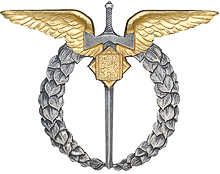




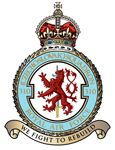
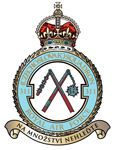
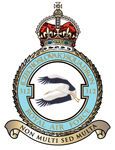
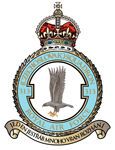


Chtěli bychom předně poděkovat neteřím a synovcům Jaromíra Drmelky, kteří nám dodali informace a fotografie k článku. Touto cestou jim děkujeme za dodané informace a fotografie k článku.
Comprehensive, well researched and interesting article. I feel humbled and honoured to know that my late mother spent a short part of her life with Jaromir. His courage, bravery and commitment, also his love for his country, are just so apparent. It is because of Jaromir, and others like him, that I was born free as like millions of us who were fortunate enough to be born into peace and democracy. Thank you.
An excellent article. A brave and honourable man.